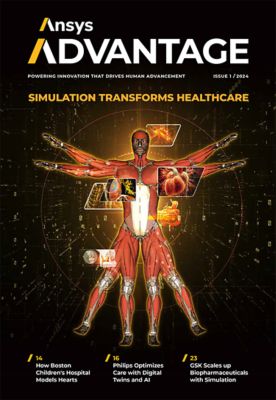-
United States -
United Kingdom -
India -
France -
Deutschland -
Italia -
日本 -
대한민국 -
中国 -
台灣
-
Ansys is committed to setting today's students up for success, by providing free simulation engineering software to students.
-
Ansys is committed to setting today's students up for success, by providing free simulation engineering software to students.
-
Ansys is committed to setting today's students up for success, by providing free simulation engineering software to students.
-
Contact Us -
Careers -
Students and Academic -
For United States and Canada
+1 844.462.6797

Is a post-pandemic healthcare sector ready to join the Fourth Industrial Revolution? This period is characterized by a shift from valuing only what is manufactured to valuing the data and connectivity of the ecosystem in which it operates — and innovation in the human interaction with such ecosystems. Key enablers of the Fourth Industrial Revolution are digitalization, data, computer modeling, and artificial intelligence (AI). These technologies build on each other and multiply both capability and value. Healthcare systems are accelerating access to data, digitalization, analytics, and predictive modeling. The mindset is shifting from treating disease to preventing it, maintaining health, improving the quality of life, and achieving healthy longevity. These are indicators that the healthcare sector is indeed primed for transitioning to the Fourth Industrial Revolution.
Where Is the Healthcare Sector Today?
The healthcare sector is one of the largest, and it has the most personal impact. Healthcare also has been criticized as one of the slowest sectors to adopt technology. The reason for that criticism is that compared with the rapid pace of software and consumer technologies, which are measured in fiscal quarters, the pharmaceutical and medical device industries measure their development cycles in years. For example, from the development of a new drug to approval for marketing often takes 10 to 15 years. Meanwhile, the average time from the concept for a new medical device to marketing is about six years. Clinicians have better, more seamless technologies in their lives as consumers than they do in their clinics and operating rooms.
Challenges for Adoption
So what are the challenges or obstacles to the adoption of computational methods by the healthcare sector? In this sector, computational methods are referred to as computer modeling and simulation (CM&S) or in silico methods (ISMs). The “in silico” terminology is an extension of how experiments are performed in biology — namely “in vitro,” which is Latin for “in the glass,” and “in vivo,” which is Latin for “in the living.” In silico methods therefore mean “in the computer, computer modeling, or computer simulation.” ISMs include simulations of bench tests, simulations of living systems, and simulations of clinical trials, also known as in silico clinical trials (ISCTs). According to surveys conducted by the Medical Device Innovation Consortium and InSilico UK across the medical device and pharmaceutical industries, the three most significant barriers to adoption of in silico methods are:
- Uncertainty in regulatory acceptance. Regulators in the different regulatory authorities vary in their experience and acceptance of modeling as evidence. Globally, geographies differ in their guidance documents, standards, and ability to accept modeling. This results in manufacturers often adopting the lowest common form of evidence that will be universally accepted.
- Scientific maturity and model credibility. Human physiology and biology is a system in dynamic equilibrium with high variability. As a result, clinical studies require a large sample size to generate sufficient evidence to identify signal in the noise and achieve statistical significance. The ability to create large volumes of models has historically been a challenge due to the computational expense and the inability to convert clinical data into simulations. These challenges are being mitigated as we can mathematically capture more biological processes, gain the ability to process clinical data using AI and machine learning (ML) techniques, and witness the continued rapid growth of compute power.
- Insufficient skills and expertise in regulation and industry. The healthcare sector requires a wide variety of expertise that comes together to deliver care, technology, and products to the sector. In this setting, computational modeling is relatively new and, compared with other industries, practitioners are 10 to 100 times less common.
Market Forces Driving Digitalization and In Silico Methods
This may imply that healthcare is indeed a slow adopter of technology, but that is not the case. When technology is presented to the sector in a way that can be easily adopted or significantly enhances the care of patients, industry is quick to act. This is seen in imaging technologies, as well as sensor and wellness technologies. However, significant market forces are driving the need for further adoption of computer modeling and simulation:
- Materials: For medical devices and pharmaceuticals, there are increasing regulations to track, report, and minimize compounds that may harm patients. A rising number of regulations from the U.S. Environmental Protection Agency have significantly impacted sterilization methods and removed compounds from the supply chain. An additional environmental consideration is that in the United States, the healthcare sector generates 5 million tons of waste per year, according to a report from Arup and Health Care Without Harm titled "Health Care's Climate Footprint."
- Eroding profit margins and moats: Over the past two years, there have been significant changes in the purchasing practices of different geographies. These resulted in a 36% drop in the per-unit price for a cardiac medication, an 80% to 90% drop in the price of certain cardiac stents, and an 80% drop in knee implant prices, depending on geography. Eroding moats come in the form of nontraditional players entering the healthcare space, including significant impact from consumer electronics. These players operate on significantly shorter product cycle times and have a longer history of simulation-driven design and digital methods. The trends affect traditional healthcare manufacturers by increasing the importance of internal efficiency, adoption of simulation-driven design, and digitalization of the product life cycle to remain competitive and maximize revenue.

“With the advances in simulation techniques and computational power, for each day that a company or product line delays adoption of modeling and simulation, a month of time is lost to a simulation-driven competitor.”
— Mark Palmer, Senior Chief Technologist for Healthcare, Ansys
- Competitive advantage: Perhaps the most significant driver for computational methods is the ways in which computational modeling impacts competitive advantage. With the advances in simulation techniques and computational power, for each day that a company or product line delays adoption of modeling and simulation, a month of time is lost to a simulation-driven competitor. The first-to-market advantage can be substantial. In medical technologies, the economic benefit from being first to market usually results in market exclusivity for 2.8 to 3.8 years, and market dominance persists beyond five years.
Three Pillars of Healthcare
The latest issue of Ansys Advantage magazine presents the role of Ansys’ healthcare strategy in supporting and accelerating innovations in healthcare. We are excited to share our three pillars of healthcare:
- Insights and personalization. The average patient does not exist. Therefore, our technologies focus on the ability to quickly generate a simulation of any patient from that patient’s own data. These personal models then can be used to evaluate multiple interventions, drug combinations, or procedural approaches.
- Democratization of simulation. Healthcare consists of a variety of experts working together. Similarly, accurate simulation of the human body must bring together many technologies and broad technical expertise. Our goal is to provide an ecosystem for creating modeling and simulation solutions tailored to each expert in the product life cycle, from design and innovation to interventional planning and clinical application.
- Digital evidence for regulatory approval. Modeling individuals and making those models easy to use by different experts enables the creation of patient populations for clinical studies without putting individuals at risk. Therefore, we are accelerating our core solver technologies, as well as increasing model prep automation, including statistical variation as an input, automating data extraction, and providing ecosystem knowledge management.
We hope that the examples of innovation we are sharing in the Simulation Transforms Healthcare issue of Ansys Advantage capture your imagination and inspire collaboration for the use of modeling and simulation to improve health and wellness around the world.
The Advantage Blog
The Ansys Advantage blog, featuring contributions from Ansys and other technology experts, keeps you updated on how Ansys simulation is powering innovation that drives human advancement.
















